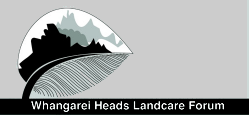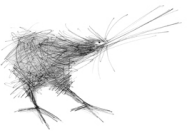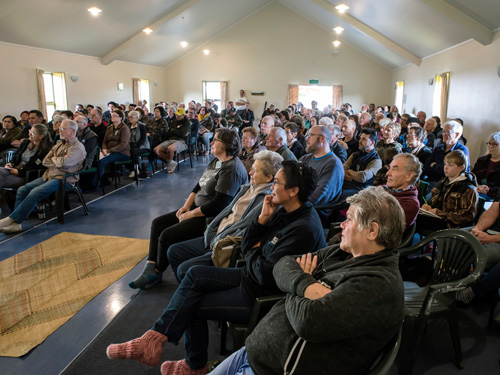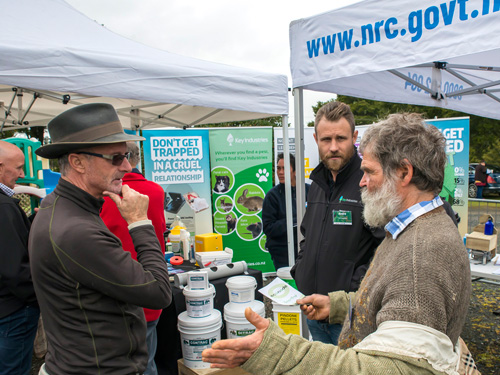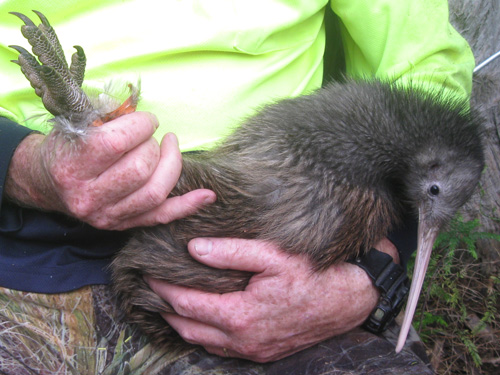2019 June Update
The National Kiwi Hui was recently held at Havelock North. It is funded by Kiwis for Kiwi and was superbly run by them and Doc’s Kiwi Recovery Group.
Thanks! It was a great chance to catch up with kiwi folk from other regions and hear what is going on. There was more science and practical evidence of the effectiveness of a 1080 pulse to give kiwi chick protection from stoats, but ferrets can remain a problem due to the quick reinvasion of a small number of adult kiwi killers – these can be overcome with well thought out and skilled trapping. We rarely catch ferrets in our area now but still have a network of traps in place for to deal with this threat. There was a small but vocal Northland representation at the hui and Stella Schmid of Bay Bush Action and Marj Cox of Mahinepua Radar Hill Landcare were deserved winners at the Kiwi Awards night and did Northland proud. Stella received the Tohu Mana Tiaki award and Maj the Northland “Good Egg” award.
Northland Pest Control Wananga
Last Sunday Kiwi Coast in partnership with NRC ran a very successful 2019 Northland Pest Control Wananga at the Akerama Marae. There was a big turn out (over 200?) and a long waiting list of late subscribers. It was another well run event updating folks on pest control happenings – special thanks to the work of Ngaire Sullivan and Ngati Hau for superb hosting (see Kiwi Coast facebook for pics and details)
Predator Free funding
Further to the NRC proposal for increased pest control in some areas of Northland, including potentially the Heads and the area north of us for possums particularly – as outlined by Kane McElrea at the AGM. The NRC proposal went to PF2050 to seek funding to supplement the funding already invested in Northland pest control by community groups, the NRC and other agencies. PF2050 have come back to the NRC with a significant funding proposal and we will hear the details of it shortly.
Kiwi Call Count
Our team of kiwi call counters have still been out there working hard counting kiwi calls. As I said last month the call counts are well down on previous years, this doesn’t mean all the kiwi have disappeared, it is just a reflection of one of the driest autumns on record. With some small rain events (showers!) lately there has been an increase in call counts compared to the first listening period but still down. Over the next few weeks we will collate the data and Fay will complete the electronic spreadsheet for submitting to Doc – please get your data sheets to me ASAP.
Backyard Kiwi Predator Control Programme :
June : Stoats 2, Weasels 3, Cats 2, Rats 56, Hedgehogs 10 and 11 possums.
June in the last month of our trapping year (funding by NRC is from 1 July to 30 June each year) And the provisional catch results for 2018-2019 are:
Stoats 21, Weasels 27, Cats 35, Rats 706, Hedgehogs 150 and 143 possums.
Stoat catches remain similar to recent years but weasels are well down on our usual 40 odd, cats about usual. Rats are our second highest tally in 17 years and 150 hedgehogs is an all time high. You may have heard or seen all the news about this year being a “plague” year for rats because of the “masting” of native forests further south. This surge in rat numbers will relate in higher stoat numbers next season which is why Doc are putting a huge effort into 1080 toxin operations in the coming spring.
What your radio tracked Backyard Kiwi have been up to:
The kiwi adults are behind schedule for breeding because of the very dry conditions restricting feed.
- Darwin – At Lamb road, in bush south of his usual territory, still high nightly activity at 12.5 hours.
- Whitu – In the pampas above the freezing works, Reotahi. Activity down a bit at 10 hours with some lower nights so may be starting to nest.
- Moa – Back over on Taurikura Bay side – behind houses. He has started nesting and is averaging 4.5 hours nightly activity.
- EB–In a pampas bush that was left during the recent milling of a pine block at Kerr road, Steady 11.5 hours activity. Rolf helped me catch him for his transmitter change. EB was 1880g in weight and poor condition. His injury from December was well healed so the poor condition is probably a result of the poor feeding conditions there at the moment. His direct neighbours (their house is only 10m from the pampas EB was in) have been hearing him call but we very pleased to meet him in ‘person’ (see pic of Charlie, Mike and Keith with Rolf and EB)
- Pakipaki– In the pampas and gorse in the “Horse Paddock” opposite the fire station. 12 hours activity.
- Ross – Still at the top end of Pepi road in the pampas. Steady 12 hours activity. Rolf helped me catch this tricky bird for his transmitter change. He was 2250g and in excellent condition – plenty of tucker for this guy in the wet valley, but no sign of a mate yet.
- Harikoa– Still in wetland NE end of Campbell road. 12.5 hours activity.
- Wally – Has moved back into the pampas area that he nested in last year at the end of Campbell road. 10 hours activity with some low nights so may be starting to nest.
- Mokopuna– No signal – should be close to Wally.
Recent Releases at Parua Bay
- Teina – He is still in the wetland in Ross’s pines, beside Taruanui road. Activity is 12.5 hours.
- Malaika – In wetland in Ross’s pines, Taraunui road. Activity is 12 hours.
- Pakiri – Has continued to move up and down Ross Road. Activity is 12 hours. Another kiwi was heard calling in the area (and confirmed by KLD – kiwi listening device recording) which may explain why Pakiri has ended up in that area.
- Awhi – After settling in the Kohinui valley opposite the pub for 2 months she has headed 2.5km eastward back to the spot that she was released at in Feb; Ross’s pine block at Taraunui rd. It took a bit of finding her after he move and involved visiting plenty of locals to “borrow” their hills to try and get a radio signal. I am always heartened by the welcome I (and more importantly the kiwi) receive when I visit these folk.
ONE program (funded by Kiwis for Kiwi):
Rewarewa
These guys are on better soils and have had more rain so are in better condition to start breeding soon.
- Ngutu Roa – 11 hours activity, usual area SW reserve.
- Sancho – no signal.
- CFU – no signal.
- Kimposter – 11.5 hours activity, usual area SE reserve.
- Nick – Usual area of Lovell’s bush, 12.5 hours activity.
- Ngaro – no signal.
Found a new unknown kiwi – 1225g, 91.4mm, MP tucked in beside a log NE end of reserve. Good to see a chick from last season make stoat safe weight. He now has the ID chip 0075A4F7E
Cheers Todd
Please note that my email address has changed to: todd.hamilton64@gmail.com
Todd Hamilton
Backyard Kiwi Project Manager
Whangarei Heads Landcare Forum











